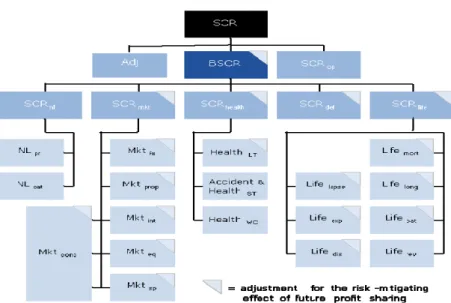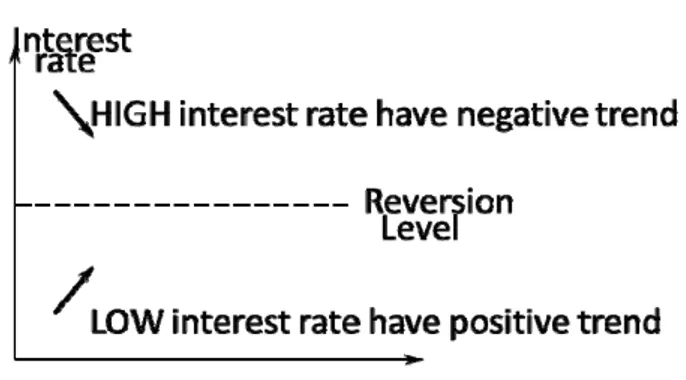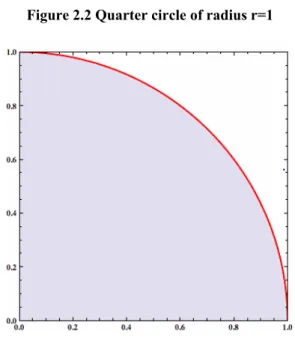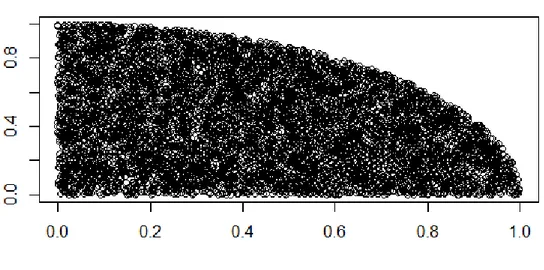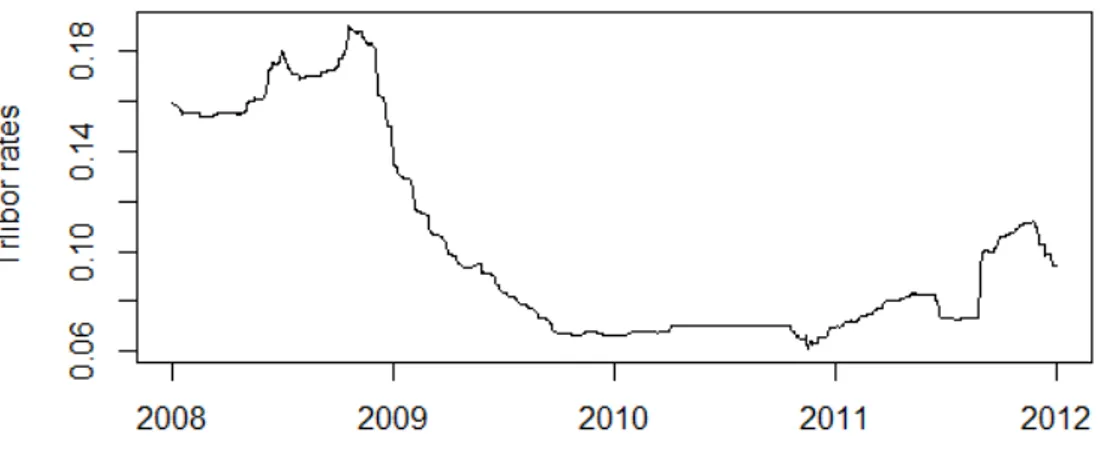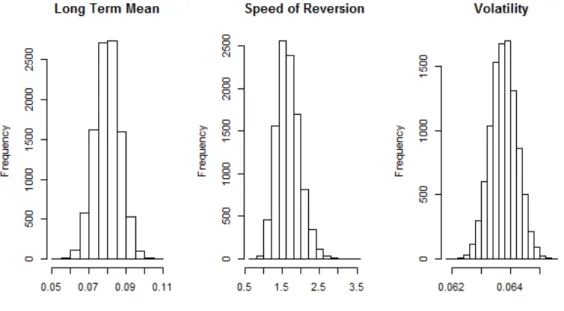(MASTER THESIS)
DISTRIBUTIONS OF THE PARAMETERS IN
VASICEK MODEL
Gönül AYRANCI
Supervisor: Yrd. Doç. Dr. Banu ÖZGÜREL Department of Actuarial Science
Bornova-İZMİR 2013
YASAR UNIVERSITY
GRADUATE SCHOOL OF NATURAL AND APPLIED SCIENCE
DISTRIBUTIONS OF THE PARAMETERS IN
VASICEK MODEL
Gönül AYRANCI
Supervisor: Yrd. Doç. Dr. Banu ÖZGÜREL Department of Actuarial Science
Bornova-İZMİR 2013
ii
This study titled “ Distributions of the Parameters in Vasicek Model” and presented as Master Thesis by Gönül Ayrancı has been evaluated in compliance with the relevant provisions of Y.U Graduate Education and Training Regulation and Y.U Institute of Science Education and Training Direction and jury members written below have decided for the defence of this thesis and it has been declared by consensus / majority of votes that the candidate has succeeded in thesis defence examination dated May 13, 2013.
Jury Members: Signature:
Yrd. Doç. Dr. Banu ÖZGÜREL ………...
Yrd. Doç. Dr. Serkan ALBAYRAK ………
ÖZET
VASICEK MODELİNDE PARAMETRELERİN
DAĞILIMLARI
AYRANCI, Gönül
Yüksek Lisans Tezi, Aktüerya Bilimleri Bölümü Tez Danışmanı: Assist. Prof. Dr. Banu ÖZGÜREL
Mayıs 2013
Bu çalışmada LIBOR TR faiz oranı verilerinin 2 Ocak 2008 – 5 Aralık 2012 tarihleri arasındaki günlük zaman serilerinin stokastik davranışlarını incelemek için Vasicek faiz oranı modeli kullanılmıştır. Modelde yer alan parametrelerin tahimininde en küçük kareler tahmin yönteminden faydalanılmıştır. Monte Carlo simulasyonu kullanılarak parametrelerin dağılımları incelenmiştir. Bu metod sayesinde sadece parametre tahmini yapılmamış, parametrelere ilişkin güven aralıkları elde edilmiştir.
Anahtar Kelimeler: Vasicek modeli, En Küçük Kareler Yöntemi, Monte Carlo
iv
ABSTRACT
DISTRIBUTIONS OF THE PARAMETERS IN VASICEK
MODEL
AYRANCI, Gönül
MSc in Actuarial Science
Supervisor: Assist. Prof. Dr. Banu ÖZGÜREL Mayıs 2013
In this study time series of TRLIBOR interest rates in different maturities are modeled with Vaiscek Model. OLS method is used for calibrating the model parameters of Vasicek to TRLIBOR rates data which is between 2.01.2008 and 5.12.2012. Then distributions of parameters are obtained by using Monte Carlo Simulation ragarding the Vaicek Model. Thus, not only parameters are estimated but also confidience intervals are given.
Keymords: Vasicek Model, Ordinary Least Square Method, Monte Carlo
ACKNOWLEDGEMENTS
I would not have been able to complete this journey without the aid and support of countless people.
First I must express my gratitude to my supervisor Assist. Prof. Dr. Banu Özgürel for the guidance, useful comments, remarks and engagement through the learning process of this master thesis.
I want to express the separate gratitude to Assist. Prof. Dr. Serkan Albayrak for his advices, irreplaceable contributions, support and especially for his helps in application of this study.
I am also grateful to Prof. Dr. Behzat Gürkan for encouragement and support in many ways to the success of this study.
Last but not least, I would like to thank my parents and friends, especially my Mother and Father for their unconditional support throughout my study.
vi
TEXT OF OATH
I declare and honesly confirm that my study titled “Distributions of Parameters in Vasicek Model”, and presented as Master’s Doctorate Thesis has been written without applying to any assistance inconsistent with scientific ethics and traditions and all sources I have benefited from are listed in bibliography and I have benefited from these sources by means of making references.
TABLE OF CONTENTS
1 INTRODUCTION ...1
2 METHODS...5
2.1 Model Description ...5
2.1.1 Vasicek Interest Rate Model...6
2.2 Parameter Estimation ...9
2.2.1 Ordinary Least Square Estimation for Vasicek Model...9
2.2.2 Maksimum Likelihood Estimation for The Vasicek Model...10
2.3 Monte Carlo Simulation...11
3 APPLICATION ...16
4 CONCLUSION ...24
viii
INDEX OF FIGURE
Figure 1.1 Risk Modules of SCR...2
Figure 2.1 Mean reversion process...7
Figure 2.2 Quarter circle of radius r=1 ...13
Figure 2.3 value estimation with Monte Carlo Method...15
Figure 3.1 Time series of TRLIBOR 1M from 2.01.2008 to 5.12.2012 ...17
Figure 3.2 Time series of TRLIBOR 6M from 2.01.2008 to 5.12.2012 ...17
Figure 3.3 Time series of TRLIBOR 1Y from 2.01.2008 to 5.12.2012 ...18
Figure 3.4 Time series of TRLIBOR overnight from 2.01.2008 to 5.12.2012...18
Figure 3.5 Plots of the parameters in simulation step...21
Figure 3.6 Histograms of the parameters in simulation step...21
Figure 3.7 Plots of the parameters in simulation step...22
INDEX OF TABLE
Table 3.1 Summary of Vasicek Estimators ...20
Table 3.2 %95 Confidence Intervals for the parameters ...23
x
INDEX OF SYMBOLS AND ABBREVIATIONS
Abbreviations Explanation
CIR Cox-Ingersoll-Ross
MLE Maximum Likelihood Estimation
OLS Ordinary Least Squares
SCR Solvency Capital Requirement
1 INTRODUCTION
Interest rates are an indicator for the global cost of the money. There are financial instruments which directly link with interest rates in portfolio of financial institutions and especially of insurance companies. Interest rates and the volatility of interest rates play a crucial role in estimation of losses which is caused for holding the money. Moreover there are some government regulations about estimation of those losses for insurance companies (Solvency II). Insurance companies have to calculate the capital requirement for the market risk under the Solvency II requirements. There is a committee that is established by Treasury on 2009 for inform the sector about Solvency II directives and assess the impact of these directives on the insurance sector. Ten insurance companies, of which 5 operate in life, 4 non-life and 1 in reinsurance, participated in these studies. The Solvency Capital Requirement (SCR) is the new solvency standard for firms in Solvency II directives. SCR is based on the idea that an insurance firm should have the amount of capital that is sufficient with a 99.5% confidence-level to guarantee that the firm will have enough assets to cover its liabilities at the end of one year period. In other words, SCR calibrated to the Value-at-Risk of basic own funds subject to a confidence level 99.5% over a 1 year time horizon. The SCR is intended to reflect all quantifiable risks that the firm might face. A basic SCR calculation divided into modules per risks, with adjustment for the loss-absorbing capacity of technical provisions and deferred taxes. These calculations must be done at least once per year using a standard formula or an internal model. But internal models improve risk sensivity of SCR and provide better risk management, which also improves policyholder protection (CP20 final advice1). Martin (2012) applies the model of Gatzert and Martin (2012) for deriving a partial internal model for the market risk module regarding the underlying interest rate process and parameters. Solvency II Directive gives an option to model only certain risk modules or business units and to use the standard formula for the remaining parts.
1 CP20 is a consaltation process initiated by CEIOPS (Committee of European Insurance and
Occupational Pensions Supervisors) on the “advice to the European Commision in the Framework of the Solveny II”
2
There is a figure below that shows the risk modules of SCR (Figure 1.1).
Figure 1.1 Risk Modules of SCR
As we can see in the Figure 1.1, interest rate risk plays a significant role for calculating SCR (Martin, 2012). The aim of this study is to evaluate model with focus on market risk module of Solvency II regarding the interest rate risk. Already it is an inevitable fact that insurance companies must have fitting interest rate model while they estimate the value at risk (VaR) on a specific portfolio of financial assets. Also Martin (2012) shows that the change in SCR is sustainable when changing the underlying interest rate model.
Modeling of interest rates is especially used for investment and financial decisions, portfolio management and insurance. Future interest rates can be predicted with a suitable interest rate model and those interest rates predictions can be used for the estimation of price of the financial instruments. An increasing number of insurance companies and other financial institutions are using stochastically generated interest rates to measure interest rate risk and to value financial assets. The use of stochastic interest rates for insurance system is both appropriate— given the stochastic nature of interest rates— and increasingly mandated by regulators at the larger more complex financial institutions. An interest rate model is a probabilistic description of the future evolution of interest rates. It characterizes the uncertainty involved in interest rates. Interest rate modeling is a very important part of any insurance. This is because the valuation of the assets and liabilities of insurance companies depends crucially on interest
rates. Also enormous literature in finance such as Vasicek (1977) and Cox, Ingersoll and Ross (CIR) (1985) have documented that interest rate should be followed by a stochastic process.
In the literature various models have been proposed such as Merton (1973), Vasicek (1977), Dothan (1978), Richard (1979), Brennan and Schwarz (1979, 1982), Cox, Ingersoll and Ross (1985), Rendleman and Bartter (1980), Longstaff (1989), Hull and White (1990), Pearson and Sun (1994). These models can be used to value all interest rate contingent claims in different cases. Major difficulty in the modeling process is to provide parameters that fit to the initial term structure of interest rates. In that case several papers focused on the estimation of the parameters in a consistent way. Chan et al. (1992) estimate and compare continuous time models of the short term riskless rate using the Generalized Method of Moments. Kladivko (2007) investigates Maximum Likelihood Estimation of the CIR process for interest rate time series. While comparing the Vasicek and CIR models, Munnik and Schotman (1992) used Ordinary Least Square Estimation method. Berg (2011) describe OLS and MLE methods calibrating the model parameters of Vasicek. Also Zeytun and Gupta (2007) analyze Vasicek and CIR models to give results for the parameters. Carriere (2000) investigate long-term yield rates for valuing a life insurance and used OLS method parameter estimation of the models such as Vasicek (1977), CIR (1985), Nelson-Siegel (1987). Önalan (2009) explains the structure of Vasicek and CIR models, then give parameter estimation methods OLS for Vaiscek, Matingale method for CIR. Moreover Şahin and Genç (2009) investigate which short term interest rate model appropriate for Turkish data.
In this paper we examine the application of the Vasicek Model with TRLIBOR data to study the term structure of interest rates. Simply the aim of this study is to determine parameters of the Vasicek model and give confidence intervals regarding to estimation of parameters. After model parameters are estimated by using OLS method, the distribution of these estimated parameters is obtained by using the Monte Carlo Simulation.
4
The rest of this thesis is organized as follows. Chapter 2 describes our model and methods that we used. This chapter is explained in three main sections. First general diffusion model description for interest rates is given and Vasicek Model examined in detail. Then OLS and MLE methods are applied for the parameters of the Vasicek Model. Last section in chapter 2 Monte Carlo method is explained with examples. Chapter 3 shows an application of parameter estimation of Vasicek Model for TRLIBOR rates. Chapter 4 summarizes the paper and gives results that we obtain.
2 METHODS 2.1 Model Description
Interest rate processes have been defined with stochastic differential equations. Generally models divided into equilibrium models and no-arbitrage models. We only focus on equilibrium models and from those only the Vasicek model describe here. The equilibrium models based on some assumptions about economic variables and give us process for the short rate, . (Hull and White 1993). To achieve a balance between supply of bonds rate and demand of the investors is the aim of the equilibrium models. The most well-known equilibrium models are Merton(1973), Vasicek(1977) and CIR(1985).
There are also single or multi-factor models for the interest rate modeling and the Vasicek model is classified as one-factor model and the interest rate is called instantaneous interest rate. In one-factor models it is accepted that there is only one source of the risk. These models may be preliminary among the recent multi-factor models but they provide a good introduction to the study of interest rates. Moreover they can be easily solved and Sorwar (2007) states that the existence of analytical solutions leads to quick valuation of the bond, option, prices, and the hedge parameters such as delta for risk management purposes.
The general formula for one-factor diffusion model is:
(1)
where is a Brownian motion process. Different forms of functions and give various diffusion models.
6
2.1.1 Vasicek Interest Rate Model
Vasicek model is a one-factor model describing an evolution of interest rates. It describes movements of interest rates as driven by source of market risk. Also it can be used for the derivatives of interest rates. It was introduce in 1977 by Oldrich Vasicek. The spot rate follows so-called Ornstein-Uhlenbeck process
and the equation has following form
(2)
(3)
where Wt is a Wiener process (also called Brownian Motion) under the risk
neutral measure modelling the random market risk factor. With ,
corresponding to the choice , in equation (1). This
description of the spot rate process has been proposed by Merton (1971).
According to the Vasicek O. (1977), Journal of Financial Economics, 5, 177-188, “The Ornstein-Uhlenbeck process with is sometimes called the elastic random walk. It is a Markov process with normally distributed increments. In contrast to the random walk (the Wiener process), which is an unstable process and after long time will diverge to infinite values, the Ornstein-Uhlenbeck process possesses a stationary distribution. The instantaneous drift represents a force that keeps pulling the process towards its long-term mean with magnitude proportional to the deviation of the process from the mean. The stochastic element, which has a constant instantaneous variance, causes the process fluctuate around the level in an erratic, but continuous, fashion”
The most important feature which this model exhibits and explained by Vasicek is the mean reversion, which means that if the interest rate is bigger than the long run mean ( then the coefficient makes the drift become negative so that the rate will be pulled down in the direction of . Similarly, if the interest rate is smaller than the long run mean ( , then the coefficient makes the drift term become positive so that the rate will be pulled up in
the direction of . Therefore, the coefficient is the speed of adjustment of the interest rate towards its long run level.
Figure 2.1 Mean reversion process
One of the most attractive feature of the Vasicek Model is that there is close form solution for . We start solution of the Stochastic Differential Equation (2) by taking the derivative of , which yields:
(4)
Substitute equation (2) into equation (4) yields;
(5)
Rearrange the equation (5) gives:
(6)
Taking integral from to for both sides of the equation (6):
8
(8)
(9)
If we multiply both sides of the equation with the solution of the differential equation (2) is:
(10)
process given in equation (10) follows a Gaussian Distribution with mean:2
(11)
and variance:
(12)
If time increases the mean tends to the long-term value and the variance remains bounded, implying mean reversion. The long-term distribution of the Ornstein-Uhlenbeck process is stationary and is Gaussian with mean and
variance . (Sypkens 2010)
2 Önalan Ö., Vasicek ve CIR Modelleri Kullanılarak Oynaklık ve Faiz Oranlarının Modellenmesi,
2.2 Parameter Estimation
2.2.1 Ordinary Least Square Estimation for Vasicek Model
The explicit solution of the Ornstein-Uhlenbeck SDE is obtained in previous section, namely:
(13)
is a random variable with mean and variance and
respectively. It is assumed that follows a process as follow:
(14)
The discrete version of the equation (13) on time grid
(equal time intervals) and
(15)
where is a Gauission white noise ( .
Parameters of eqaution (14) is:
(16)
(17)
(18)
Rearrange equations (16), (17) and (18) in terms of the parameters α, β, and which yield:
10
, , (19)
The formulas for the least squares estimates a, b, and are:
(20)
(21)
(22)
2.2.2 Maksimum Likelihood Estimation for The Vasicek Model
MLE method is consistent for the Vasicek model since its error term is normally distributed (Ren Raw Chen, 1996). So, the likelihood function can be derived for the MLE. We need to define the likelihood function and find the paremeters that maximize the likelihood function. There is different methods in literature for maximize the methods likelihood function (Sypens, 2010). Optimization method is explained for this problem. The conditional probability function is derived by combining the solution of our model with the normal distribution function (Calibrating the Vasicek Thijs Von den Berg, 2011).
(23)
If is given, the conditional density function of on the time grid , with equal time step by using equation (11) and (12).
(24)
Since the logarithmic function is monotonically increasing, maximizing the log-likelihood function also maximizes the log-likelihood function. The log-log-likelihood function is;
(25)
We can find the maximum likelihood estimates of parameter vecor by maximizing maximizing the log likelihood function (Equation 25):
(26)
2.3 Monte Carlo Simulation
Monte Carlo means using random numbers in scientific computing. More precisely, it means using random numbers as a tool to compute something that is not random. One of the first uses of this method is suggested by Buffon (1777) with an experiment that calculates the probability that the needle intersect one of the lines on a horizontal plane, now known as the famous Buffon’s Needle Problem. Later Laplace (1886) suggested the idea of evaluating with Monte
12
Carlo Simulation. Also it is used in kinetic theory of gases by Kelvin (1901). But the method today labeled as “Monte Carlo Method” is formally introduced to the literature by Ulam (1940) where he advocated the use of computers in an integration problem related to Manhattan Project which has no formal solution.
The process of method can be explained as follows: During a Monte Carlo Simulation, values are chosen randomly from the input probability distributions. These generated samples are called iterations and results from the samples are recorded for each iteration. Through Monte Carlo simulation, this process can be done hundreds and thousands times. In this way, Monte Carlo simulation provides much more extensive information about what may happen and how likely it is to happen.
We can explain Monte Carlo method further with a nice and well-known example of value estimation. is a constant that is the ratio of a circle’ circumference to its diameter.It is simply accepted as 3.14 but true value cannot represent as a finite decimal fraction. Let us consider a unit circle with a radius 1. If is a point on the unit circle, by the Pythagorean Theorem, that satisfy the following equation;
(27)
By choosing random points on the plane, we need to decide each point that we have chosen whether is within the circle or not. The quarter unit circle is considered as shown in the following figure.
Figure 2.2 Quarter circle of radius r=1
Since we know the area of a circle with radius .
(28)
The unit circle area is equal to and the area of the quarter circle that we
interested is equal to . We have to look at the unit circle (radius = 1) within a square with sides equal to 1 (see Figure 2.2). Now if we pick a random points where both and are between from 0 to 1. The probability of that this random point lies inside the unit circle is given as the proportion between the area of the unit circle and the square :
(29)
If we pick a random point times and of those times the point lies inside the unit circle, the probability of that a random point lies inside the unit circle is given as :
14
where the dot indicates that this is a discreet distribution (because M and N are integers). But if N becomes very large (theoretically infinite), the two probabilities will become equal and we can write :
(31)
Monte Carlo method applied and simulation run 10000 times to approximating the value of . Obtaining results and the codes relating to the process are given (Figure 2.3).
n=10000 x=runif(n) y=runif(n) counter=0 plot(NA,type="n",xlim=c(0,1),ylim=c(0,1), xlab="n=10000",ylab="") for (i in 1:n){ if ((x[i]^2+y[i]^2)<=1) { counter=counter+1 points(x[i],y[i],type="p") } } 4*counter/n
Figure 2.3 value estimation with Monte Carlo Method
Monte Carlo simulation can be used to approximate probability distributions of functions of random variables. For example, let be a random variable and its
expected value be If we generate independent random
variables from the same distribution then we can approximate by
(32)
The strong law of large numbers states that . Albeit the generated random numbers would be different each time and therefore so does the sample average, , the target number, , is fixed and nonrandom. Using thousands of Monte Carlo runs one can approximate the distribution of , around
Monte Carlo Methods allows us to account for risk in quantitive analysis and decision making. The technique is used in various fields such as finance (Haugh, 2004), project management (Kwak and Ingall, 2007), manufacturing (Pica et al., (2006), engineering (Amar, 2006), insurance (Collins, 1962), the environmental and resource economics (Scarpa and Alberini, 2005).
16
3 APPLICATION
In this thesis, we are going to use TRLIBOR data with different time to maturities. The Turkish Lira Interbank Offered Rate, or TRLIBOR, is the average interest rate at which term deposits are offered between prime banks in the Turkish wholesale money market or interbank market.
TRLIBOR initiated on August 1, 2002 by the Banks Association of Turkey and has resulted in the formation of benchmark interest rates that the economic agents base their projections. The formation of benchmark interest rates is an important development as they will increase transparency of the markets, form a sound yield curve in money markets and improve forward transactions by pricing financial assets more effectively.
Our study sample from the web page of the Banks Association of Turkey TRLIBOR3 data period is from 2.01.2008 to 5.12.2012 and contains 1230 daily observations for each time maturity. The rates are shown in the following figures in different maturities, 1 month (Figure 3.1), 6 month (Figure 3.2), 1 year (Figure 3.3) and overnight (Figure 3.4).
Figure 3.1 Time series of TRLIBOR 1M from 2.01.2008 to 5.12.2012
Figure 3.2 Time series of TRLIBOR 6M from 2.01.2008 to 5.12.2012
3 http://www.tbb.org.tr
18
Figure 3.3 Time series of TRLIBOR 1Y from 2.01.2008 to 5.12.2012
It can clearly be seen from the figures (Figure 3.1, Figure 3.2 and Figure 3.3) in 1 month, six month and 1 year maturities same pattern is observed. TRLIBOR rates were extremely high at the start of monitored period, especially in last months of 2008. After that there is a dramatic fall occurred in earlier months of 2009 and then it seems stable from 2010 to 2011. Finally, there is an increasing trend between the year 2011 and 2012.
Figure 3.4 Time series of TRLIBOR overnight from 2.01.2008 to 5.12.2012
In the case of overnight maturity, we observed a pattern that more sensitivethan the others especially on the last interval from 2011 to 2012. So to estimate the parameters of Vasicek Model we use the daily TRLIBOR data with overnight maturity.
The time series plots of our sample data is shown in the figures above. Since we can observe from the figures, modeling interest rates is a very complex and hard task. So Vasicek Model parameters will be estimated using TRLIBOR data.
(33)
(34)
where speed of mean reversion long run mean
instantaneous volatility Weiner process
In order to estimate the development of the instantaneous interest rate the Euler-discretisation of the Vasicek Model (Equation 33) is used and is given:
(35)
where is generated random number from (Josef, 2009).
In the simulation process, the most important step is to estimate the parameters of our model accurately. Parameter estimation methods regarding the Vasicek Model are described in Chapter 2. Estimation of parameters with OLS method gives very similiar results to MLE (Sypkens, 2010). To estimate the parameters of our model we use OLS method and run the R code below which estimates required parameters (Table 3.1)
Vasicek.OLS = function(data,dt){ N = length(data) rate = data[2:N] lagrate= data[1:(N-1)] a=(N*sum(rate*lagrate)-sum(rate)*sum(lagrate))/ (N*sum(lagrate^2)- sum(lagrate)^2) alphahat = -log(a)/dt
20
v2hat=sum((rate-lagrate*alpha-betahat*(1-a))^2)/N sigmahat=sqrt(2*alpha_hat*v2hat/(1-a^2))
c(betahat,alphahat,sigmahat)}
Table 3.1 Summary of Vasicek Estimators
OLS 0.0799080219842794 1.55095522339525 0.0635675446843325
To estimate distribution of the parameters that fits Vasicek Model, Monte Carlo Simulation explained in Chapter 2 is used and the codes of process are given:
init.value=test.data[sizedata[1]] sizeofsim=1000 sizeofMonteCarlo=1000 delta.t=1/260 set.seed(1) TEZ=matrix(data=NA,nrow=sizeofMonteCarlo,ncol=3) for (j in 1:sizeofsim){ r=init.value for (i in 2:sizeofsim){ delta.r=(outt[2]*(outt[1]-r[(i-1)])*delta.t)+(outt[3]*rnorm(1)*sqrt(delta.t)) tempo=r[(i-1)]+delta.r r=c(r,tempo) } TEZ[j,]=Vasicek.OLS(data=r,dt=1/260) }
In each run of the Monte Carlo Simulation process, new parameter values are estimated from the interest rate observations. Each run initiates from a different
random point. Furthermore at each step randomized variates enter the model distinguishing each run. Monte Carlo does this process thousands of times. This process runs with two simulation steps. The histograms and plots of the simulation results are given.
Figure 3.5 Plots of the parameters ( ) in simulation step
Figure 3.6 Histograms of the parameters ( ) in simulation step
As we can see in the Figure 3.5 observations of estimation, which of long run mean from simulated values of interest rate, have extreme values (outliers) relative to other observations. Ghosh and Vogt (2012) states that there is three main approaches to eliminate outlier problems:
22
1. To keep the outlier and treat it like any other data point 2. To modify its value
3. To eliminate it
Also they state that method 2 and 3 introduce statistical bias and may undervalue the outlier.
To obtain distribution of parameters, increase our sample size the simulation step is increased to 10000 times.
Figure 3.8 Histograms of the parameters ( ) in simulation step
Now after the simulation with time step n=10000, parameters are normally distributed as it can be observed in the Figure 3.7 and Figure 3.8. We give our results in Table 3.2 %95 confidence intervals and Table 3.3 %99 confidence intervals for the estimated parameters.
Table 3.2 %95 Confidence Intervals for the parameters
Parameters %95 Confidence Interval
Long Term Mean 0.06697832 0.09310074
Speed of Reversion 1.126175 2.326765
Volatility 0.06288429 0.06465596
24
Parameters %99 Confidence Interval
Long Term Mean 0.06288056 0.09721137
Speed of Reversion 1.015408 2.585334
Volatility 0.06265065 0.06454089
As we can see from Table 3.2 , there is a significant difference between the confidence interval borders for the long term mean and speed of reversion parameters. Also increasing confidence level (%99) caused increase in interval length. Any chosen parameter ignores the confidence intervals may cause over estimation or under estimation of the model parameters and interest rates.
4 CONCLUSION
This study has been focuses on the distribution of the Vasicek Model parameters. First we emphasized the importance of interest rate modeling especially in insurance sector. As we indicate in introduction, with the new regulations about capital requirements (Solvency II) modeling interest rates arise one of the most important problem in that field. First we gave a general form of the stochastic differential equation for the interest rate modeling. The focus is on the Vasicek Model. The solution of the stochastic differential equation of Vasicek Model is given and it is shown that two different parameter estimation methods,
Ordinary Least Square and Maximum Likelihood estimation, can be applied to the model. Then Monte Carlo Simulation Method is explained.
In the third part of this study is the application of the model on a data set from TRLIBOR rates. We simulated new data set that is approximated by Euler discretization with parameters from OLS estimators. This process applied with Monte Carlo Method for 1000 time steps and 10000 time steps. First simulation gave us distribution of the long term mean with outliers and also high variance. In order to achieve greater accuracy, we increased the sample size to 10000. After we clearly saw that our estimated parameter values from simulations are normally distributed, we gave our results with the %95 and %99 confidence intervals for the parameters.
In this study our aim is observing the distribution of the Vasicek Model parameters. There are already various studies about parameter estimation of the Vasicek and other diffusion models. But we used Monte Carlo Method for obtaining the distribution of the estimated parameters. Through this technique we observed probability distributions of parameters and we also got confidence intervals. It can be clearly seen major difference between the borders of the intervals for long term mean and mean reversion parameters. So during the parameter estimation process confidence intervals are necessary for more accuracy. This step is the key element of our study because probability distributions are much more realistic way describing uncertainty in variables of risk analysis.
5 BIBLIOGRAPHY
Berg T., Calibrating the Ornstein-Uhlenbeck (Vasicek) Model,2011
Sorwar, G., Barone-Adesi, G. and Allegretto, W., (2007)., "Valuation of
Derivatives Based on Single-Factor Interest Rate Models", Global finance journal, Vol.18
26
Brigo, D., Neugebauer, M., Dalessandro, A., and Triki, F., (2009). A stochastic
Processes Toolkit for Risk Management, Journal of Risk Management in Financial Institutions, Vol. 3, 1.
Hsiao C. and Semmler W., Modeling Short Term Interest Rates, (2002), Elsevier
Science
Josef O. (2009), Models of Interst Rate Evolution-Vasicek and CIR Models,
Journal of Applied Mathematics, volume II
Önalan Ö., (2009) Vasicek ve CIR Modelleri Kullanılarak Oynaklık ve Faiz
Oranlarının Modellenmesi, Marmara Üniversitesi, İ.İ.B.F. Dergisi, Sayı II, S. 329-344.
Şahin H. and Genç İ., (2009), Kısa Dönem Faiz Modellerinin Türkiye için
Ampirik Analizi, BDDK Bankacılık ve Finansal Piyasalar, Cilt 3, Sayı 2.
Vasicek O., (1977), An equilibrium characterization of the term structure, Journal
of Financial Economics, 5, 177.186.
Benninga S. and Wiener Z., (1998), Term Structure of Interest Rates,
Mathematica in Education and Research, Vol. 7 No. 2
Martin M., (2012), Assessing the Model Risk with Respect to the Interest Rate
Term Structure under Solvency II, FAU.
Zeytun S. and Gupta A., (2007), A Comparative Study of the Vasicek and the
CIR Model of the Short Rate, Berichte des Fraunhofer ITWM, Nr. 124
Hull J. and White A., (1990), Pricing Interst Rate Derivative Securities, The
Review of Financial Studies, Volume 3, number 4, p. 573-392.
Tang C. and Chenb S., (2009), Parameter Estimation and Bias Correction for
Difusion Processes., Journal of Econometrics 149, (2009) 65-81.
Acar O., (2009), Avrupa Birliği Solvency II Projesi, Türkiye Sigorta ve
Reasürans Şirketler Birliği.
Giaccotto C., Stochastic Modeling of Interest Rates: Actuarial vs. Equilibrium
Approach, The Jourmal of Risk and Insurance.
Cairn A., (2004), Interest Rate Models, Princeton University Press.
Semir C. and Taray M., (2005), Türk Lirası Referans Faiz Oranı-TRLIBOR
